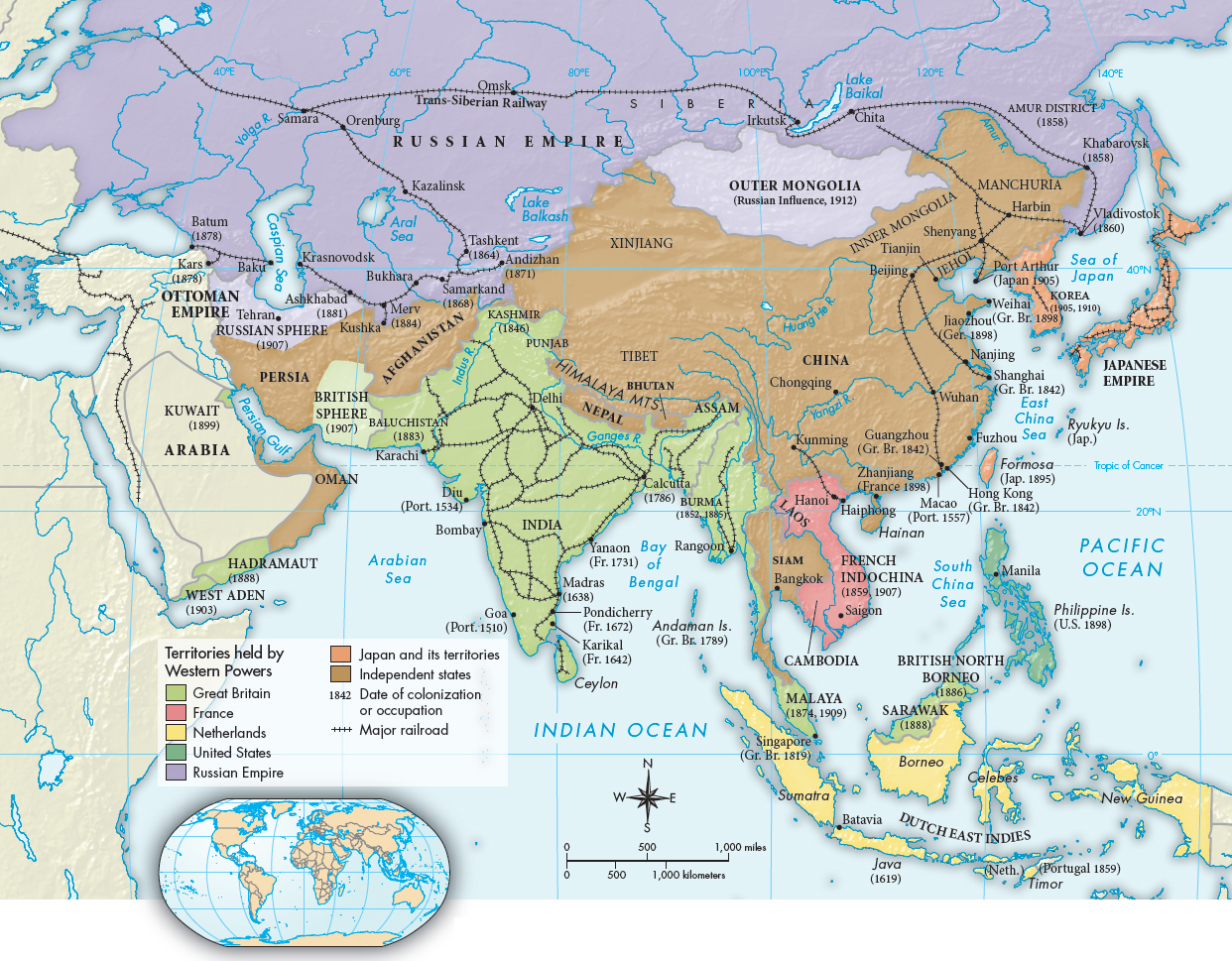Understanding World Societies:
Printed Page 784
Chapter Chronology
The British and the Indian Educated Elite
The Indian middle class probably gained more than the poor from British rule, because they were the ones to benefit from the English-language educational system Britain established in India. Missionaries also established schools with Western curricula High-caste Hindus came to form a new elite profoundly influenced by Western thought and culture.
By creating a well-educated, English-speaking Indian elite and a bureaucracy aided by a modern communication system, the British laid the groundwork for a unified, powerful state. Britain placed under the same general system of law and administration the various Hindu and Muslim peoples of the subcontinent who had resisted one another for centuries. University graduates tended to look on themselves as Indians more than as residents of separate states and kingdoms, a necessary step for the development of Indian nationalism.
Some Indian intellectuals sought to reconcile the values of the modern West and their own traditions. Rammohun Roy (1772–1833) founded a college that offered instruction in Western languages and subjects. He also founded a society to reform traditional customs, especially child marriage, the caste system, and restrictions on widows. He espoused a modern Hinduism founded on the Upanishads (oo-PAH-nih-shadz), the ancient sacred texts of Hinduism.
The more that Western-style education was developed in India, the more the inequalities of the system became apparent to educated Indians. Indians were eligible to take the examinations for entry into the elite Indian Civil Service, the bureaucracy that administered the Indian government, but the exams were given in England. Since few Indians could travel such a long distance to take the test, in 1870 only 1 of the 916 members of the service was Indian. In other words, no matter how Anglicized educated Indians became, they could never become the white rulers’ equals. The top jobs, the best clubs, the modern hotels, and even certain railroad compartments were sealed off to brown-skinned men and women. Most of the British elite considered all Indians to be racially inferior.
The peasant masses might accept such inequality as the latest version of age-old class and caste hierarchies, but the well-educated, English-speaking elite eventually could not. They had studied not only Milton and Shakespeare but also English traditions of democracy, liberty, and national pride.
In the late nineteenth century the colonial ports of Calcutta, Bombay, and Madras, now all linked by railroads, became centers of intellectual ferment. In these and other cities, newspapers in English and in regional languages gained influence. Lawyers trained in English law began agitating for Indian independence. By 1885, when a group of educated Indians came together to found the Indian National Congress, demands were increasing for equality and self-government. The Congress Party called for more opportunities for Indians in the Indian Civil Service and reallocation of the government budget from military expenditures to the alleviation of poverty. The party advocated unity across religious and caste lines, but most members were upper-caste, Western-educated Hindus.
Defending British possessions in India became a key element of Britain’s foreign policy during the nineteenth century and led to steady expansion of the territory Britain controlled in Asia. By 1852, the British had annexed all of the kingdom of Burma, administering it as a province of India. The establishment of a British base in Singapore was followed by expansion into Malaya (now Malaysia) in the 1870s and 1880s. In both Burma and Malaya, Britain tried to foster economic development, building railroads and promoting trade. Burma became a major exporter of timber and rice, Malaya of tin and rubber. So many laborers were brought into Malaya for the expanding mines and plantations that its population came to be approximately one-third Malay, one-third Chinese, and one-third Indian.

MAP 26.1Asia in 1914India remained under British rule, while China precariously preserved its political independence. The Dutch Empire in modern-day Indonesia was old, but French control of Indochina was a product of the new imperialism.> MAPPING THE PAST
ANALYZING THE MAP: Consider the colonies of the different powers on this map. What European countries were leading imperialist states, and what lands did they hold? Can you see places where colonial powers were likely to come into conflict with each other?CONNECTIONS: Do the sizes of the various colonial territories as seen on this map adequately reflect their importance to the countries that possessed them? If not, what else should be taken into account in thinking about the value of these sorts of colonial possessions?
Why did opposition to British rule among Indian elites increase in the late nineteenth century?
